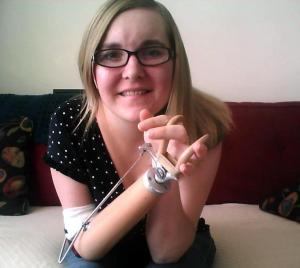 “I promise your child couldn’t possibly ask me anything I haven’t been asked before.”
“I promise your child couldn’t possibly ask me anything I haven’t been asked before.”
This is my usual reassurance to uneasy parents as their children approach me with questions about my prosthetic arm. After thirty-odd years of using a prosthetic device in my everyday life, I have answered every question under the sun more times than I can count. Or so I thought.
Recently a little boy was particularly fascinated by the mechanics of my fake arm. He exclaimed, “This is the most amazing contraption!” with such adorable enthusiasm that I felt extra disappointed that I couldn’t answer his follow up question: Who invented it?
I have never been asked this before. That’s kind of surprising, now that I think about it. With all the interest in inventors and engineers in my world (education/libraries), you would think someone would have been curious enough about whoever might have been the brains behind my prosthetic arm to ask about it.
It seems that when it comes to prosthetics, people are only interested in the future. Robot arms. 3-d printing. Bionics. Those are the topics that get the headlines and the general interest. I can’t count the number of times I’ve been asked why I don’t have a robot arm.
In an effort to be prepared for the question should it ever come up again, I did a bit of looking into the history of prosthetics. It turns out that a man named D.W. Dorrance invented the split hook device in 1912. Dorrance was an amputee himself, and he wasn’t happy with the functionality of the prosthetic devices available at the time. So he made his own, which is pretty cool.
Here’s the really unbelievable part though: Dorrance’s design, with few modifications, is still the industry standard over 100 years later. It’s what I’ve used for most of my life. It may not seem as cool as the robot arms you saw in some news story, but it’s surprisingly functional. My split hook device is infinitely more useful to me than the more hand-like prosthetic devices I’ve used in my life as well as the 3-d printed accessories I’ve tried (though the typing tool prototype I have from a 3d printing company is pretty awesome). I guess the old adage is true: if it ain’t broke, don’t fix it. In any case, it’s a rather impressive story. How many inventors can say that their inventions have remained in use for so long with so few changes?
I’d love to be able to point kids to books about the history of prosthetics, especially one that includes Dorrance’s story, but there’s almost nothing out there. While I am the first to be interested in news stories about some cool new tech that might benefit amputees like me someday, I can’t help but wish for some celebration of the past or acknowledgment of the present.

The one book that I can recommend on the subject is Artificial Limbs by Kira Freed. This is part of the Miracles of Medicine series from an educational publisher, and it is aimed at upper elementary age kids. I have a few minor quibbles with the wording here and there, but overall, the book offers a good explanation of how prosthetic arms like mine work without getting lost in technological possibilities. I, for one, appreciate that more than you might think.
 I have been eagerly awaiting the publication of New Hands, New Life: Robots, Prostheses, and Innovation, which looks to be a look at the ways that assistive technology has helped kids who have various disabilities. I am particularly curious to see how it will balance the present and the future. If we are to have yet another book that focuses too far ahead, I just may have to write the book I want to see. ;)
I have been eagerly awaiting the publication of New Hands, New Life: Robots, Prostheses, and Innovation, which looks to be a look at the ways that assistive technology has helped kids who have various disabilities. I am particularly curious to see how it will balance the present and the future. If we are to have yet another book that focuses too far ahead, I just may have to write the book I want to see. ;)




 Shark Girl by
Shark Girl by 





